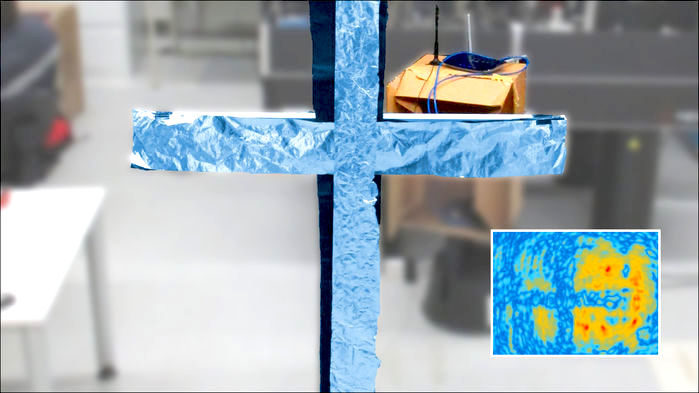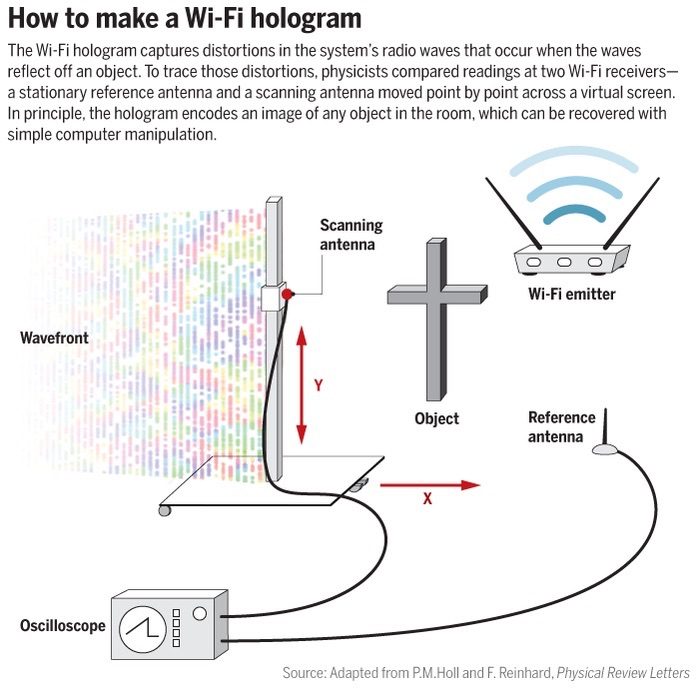
© P. M. Holl and F. Reinhard, Physical Review Letters
Your wireless router may be giving you away in manner you never dreamed of. For the first time,
physicists have used radio waves from a Wi-Fi transmitter to encode a 3D image of a real object in a hologram similar to the image of Princess Leia projected by R2D2 in the movie
Star Wars. In principle, the
technique could enable outsiders "see" the inside of a room using only the Wi-Fi signals leaking out of it, although some researchers say such spying may be easier said than done.
The idea came about a few years ago, says Friedemann Reinhard, an expert on quantum sensors at the Technical University of Munich (TUM) in Germany. "At lunch we had a discussion about
what the world would look through Wi-Fi eyes," he says, "and it became clear that if you want to see the world through Wi-Fi, you could
make a hologram."A camera makes an image by collecting light reflected from an object and focusing it onto a screen to
create a 2D pattern of greater or lesser intensity: the image. In contrast,
a hologram more fully exploits the wave nature of light. Typically, lasers are used.
The laser beam is split, and half of it reflects off the object and onto a photographic plate. The other half—the reference beam—shines directly on the plate. Like evenly spaced water waves lapping on a beach,
the light waves in the reference beam arrive in flat wave fronts. In contrast,
those reflected by the object are modified by it, and so some parts of the wave front arrive at the plate earlier and others later, depending on where they bounced off the object.
The interference of the two sets of waves creates a pattern of bright and dark spots—the hologram.
Seemingly random, the 2D hologram looks nothing like the object. But the
3D ghost of the object can be retrieved by shining another beam like the reference beam on the plate, as the light waves scatter or "diffract" in a way that reproduces the wave fronts originally reflected from the object.
Now, Reinhard and Philipp Holl, an undergraduate at TUM, have used
radio waves from a Wi-Fi router instead of a laser to
produce a hologram of a thin aluminum cross measuring about a meter wide, as they report in a paper in press at
Physical Review Letters.
Their experiment relies on none of the billions of digital bits of information encoded in Wi-Fi signals, just the fact that the signals are clean, "coherent" waves. However,
instead of recording the key interference pattern on a photographic plate, the researchers record it with a Wi-Fi receiver and reconstruct the object in a computer. They placed a Wi-Fi transmitter in a room, 0.9 meters behind the cross. Then they placed a standard Wi-Fi receiver 1.4 meters in front of the cross and moved it slowly back and forth to map out a "virtual screen" that substituted for the photographic plate. Also, instead of having a separate reference beam coming straight to the screen, they placed a second, stationary receiver a few meters away, where it had a direct view of the emiter.

© P.M .Holl and F. Reinhard, Physical Review Letters
For each point on the virtual screen, the researchers compared the signals arriving simultaneously at both receivers, and
made a hologram by mapping the delays caused by the aluminum cross. The virtual hologram isn't exactly like a traditional one, as researchers can't recover the image of the object by shining more radio waves on it. Instead, the scientists
used the computer to run the radio waves backward in time from the screen to the distance where wave fronts hit the object. The cross then popped out."It's obvious from the image that there's a cross there," says Neal Patwari, an electrical engineer at the University of Utah in Salt Lake City. "That's very impressive." But he cautions that the method might not work well in a cluttered environment.
Moreover, the receivers and object were in the same room, where the cross could easily be seen.
In principle, it should be possible to station Wi-Fi receivers outside a room and image objects on the inside, Reinhard says. However, Mark Coates, a computer engineer at McGill University in Montreal, Canada, who was not involved in the project, cautions that it may be tricky, especially if the walls have metal studs, which would also reflect radio waves. "Basically, there are waves coming from so many directions that this technique is going to much more challenging," Coates says.
Primarily Reinhard imagines putting an array of Wi-Fi sensors in the ceiling of a factory to make holograms that can better track products labeled with radio-frequency identification tags. Patwari notes that other researchers have already developed simpler ways to
use stray Wi-Fi signals to track the movement of people within buildings. Such radio tracking techniques will soon take off, Patwari predicts:
"In 5 to 10 years were going to be using Wi-Fi more for localization than for communication."
Comment: More beaming in our future...'Room Wars?'